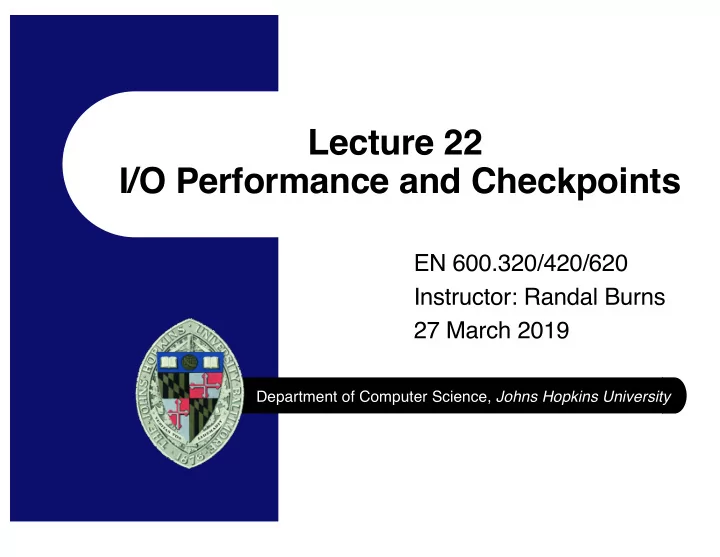

Lecture 22 I/O Performance and Checkpoints EN 600.320/420/620 Instructor: Randal Burns 27 March 2019 Department of Computer Science, Johns Hopkins University
The I/O Crisis in HPC In a world where FLOPS is the commodity……. …..Disk I/O often limits performance l Any persistent data must make it off the supercomputer – To magnetic or solid state storage l Storage is not as connected to the high-speed network as compute – Because it needs to be shared with other computers – Because it doesn’t add to TOP500 benchmarks Lecture 22: Checkpoint I/O Performance
Where does the I/O Come From? l Checkpointing! – And, writing output from simulation (which is checkpointing) l Checkpoint workload – Every node node writes local state to a shared file system – Using POSIX calls (FS parallelized) or MPI I/O J. Bent et al. PLFS: A Checkpoint File Systems for Parallel Applications. SC, 2009. Lecture 22: Checkpoint I/O Performance
Why Checkpointing l At scale failures occur inevitably – MPI synchronous model means that a failure breaks the code – Lose all work since start (or restart) l Each checkpoint provides a restart point – Limits exposure, loss of work to last checkpoint l By policy, all codes that run at scale on supercomputers MUST checkpoint! – HPC centers want codes to do useful work Lecture 22: Checkpoint I/O Performance
Checkpoint Approaches l Automatic: store contents of memory and program counters – Brute force, large data, inefficient – But easy, no development effort – New interest in this approach with the emergence of VMs and containers in HPC. l Application specific: keep data structures and metadata representing current progress. Hand coded by developer. – Smaller, faster, preferred, but tedious. – Almost all “good” codes have application specific checkpoints Lecture 22: Checkpoint I/O Performance
A Checkpoint Workload l IOR benchmark – Each node transfers 512 MB l Barriers l How much parallelism? l What effects? M. Uselton et al. Parallel I/O Performance: From Events to Ensembles. IPDPS, 2010. Lecture 22: Checkpoint I/O Performance
I/O Rates and PDF l What features do you observe? M. Uselton et al. Parallel I/O Performance: From Events to Ensembles. IPDPS, 2010. Lecture 22: Checkpoint I/O Performance
I/O Rates and PDF l What features do you observe? – Lagging processes = not realizing peak I/O performance – Harmonics in I/O distribution = unfair resource sharing M. Uselton et al. Parallel I/O Performance: From Events to Ensembles. IPDPS, 2010. Lecture 22: Checkpoint I/O Performance
Statistical Observations l Order statistics – Fancy way of saying, the longest operation dominates overall performance l Law of large numbers – I don’t think that they make this analysis cogent – It’s right, but Gaussian distribution is not what matters – A better, intuitive conclusion is l (RB interprets) smaller files are better – The worst case slow down on a smaller transfer takes less absolute time than on a large transfer – As long as transfers are “big enough” to amortize startups costs Lecture 22: Checkpoint I/O Performance
Smaller Files Improve Performance l Non-intuitive – Smaller operations seems like more overhead – But, a property of statistical analysis l Smaller better as long as fixed costs are amortized – Obviously, 1 byte is too small Lecture 22: Checkpoint I/O Performance
The Checkpoint Crisis As HPC codes get larger, I/O becomes more critical l Some observations – Checkpoint to protect against failure – More components increase failure probability – FLOPs grows faster than bandwidth l Conclusion – Must take slower checkpoints more often – Eventually you will get no constructive work done between checkpoints l Mitigation (just delaying the problem) – Burst buffers: fast (SSD) storage in high-speed network – Observe the checkpoint persistence is shorter than needed for output/analysis data Lecture 22: Checkpoint I/O Performance
Recommend
More recommend